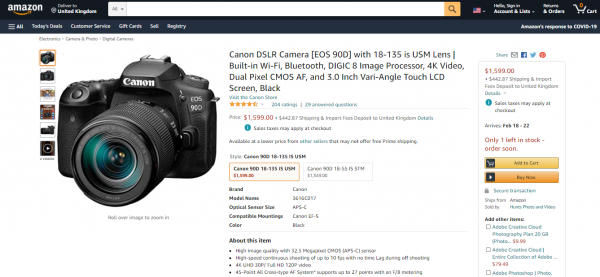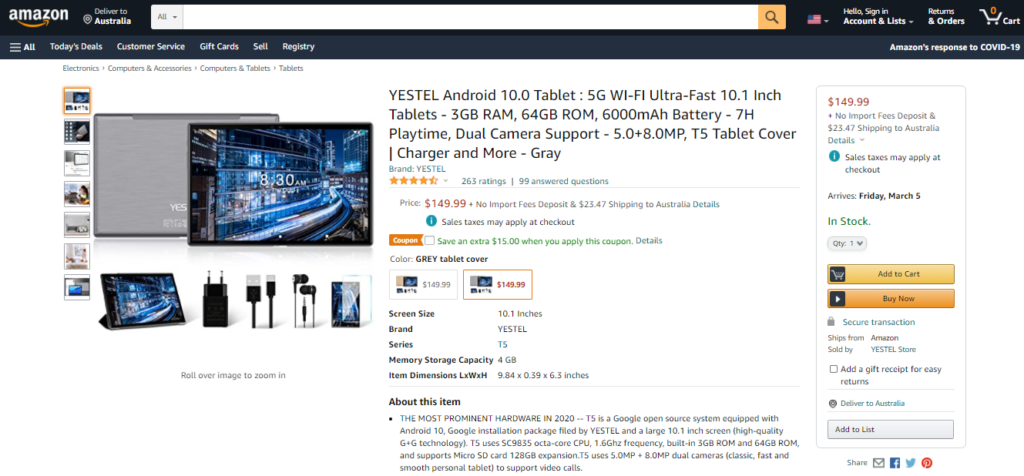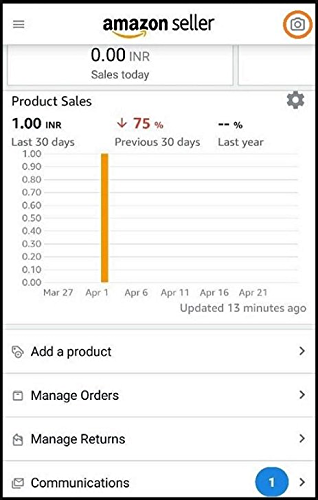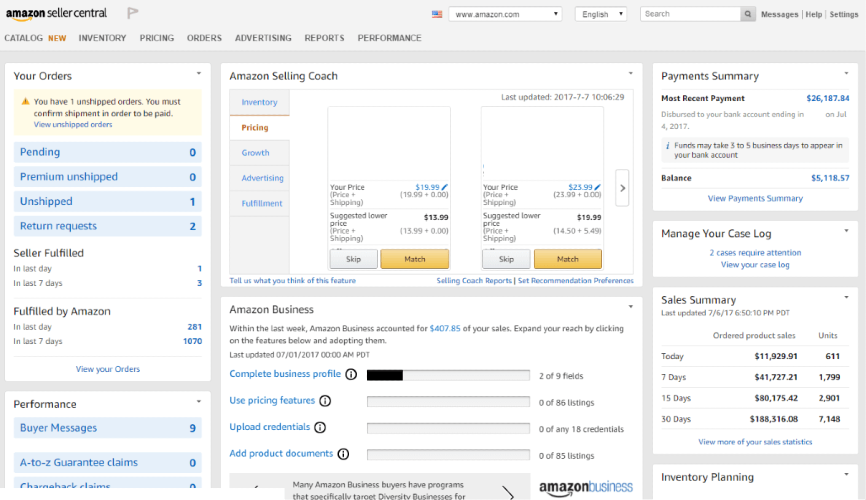Amazon Product Listings From A to Z: The Complete Optimization Guide
A fully optimized listing impacts everything from organic search ranking to return on ad spend. Follow this step-by-step guide to transform your listing into a year-round product selling machine!

Over the last decade, Amazon has become the preferred option for eCommerce sellers looking to grow their business. That has helped make it a competitive marketplace with over 9.6 million sellers grossing millions of dollars in sales. In the fourth quarter of 2022, 59 percent of all paid units were sold by third-party sellers.
All of that competition is hard to ignore. Even if you are selling a high-demand product, there are millions of other products from competing sellers. Getting your products in front of shoppers has become increasingly challenging.
Thinking About Hiring an Amazon Management Agency?
Canopy’s Partners Achieve an Average 84% Profit Increase!
Let’s talkYou might be wondering, how do I stand out from the competition?
The good news is that you can boost your product visibility and Amazon product ranking by optimizing your product listing. Understanding the concept of product listing optimization and putting it into practice can help you increase conversions and take your business to the next level.
In this post, we provide a step-by-step guide on optimizing your product listing, boosting product visibility, and driving sales.
But first, we’re going to have to do a little keyword research.
Keyword Research
Like other search engines, keywords play a crucial role in Amazon product search results and product rankings. Keyword research aims to discover words, phrases, and terms that your customers are searching for and rank for those keywords.
Adding relevant keywords to your product listings will make your products rank higher and appear when customers use those search queries. If you don’t carry out keyword research, you could miss out on potential sales opportunities.
You can start by making a list of keywords you think customers may use to search for your products. Then you can use the Google Keyword Planner, third-party Amazon apps, and other keyword research tools to find more specific and relevant search terms for your product.
Don’t rush this process. The most beautiful listing won’t get found on Amazon without the right keywords.
How To Optimize Your Amazon Product Listing
Amazon Listing optimization involves improving your product detail pages to boost visibility and enhance clickthrough rate (CTR), conversion rate (CVR), and sales. The product detail page carries all the relevant information about your product. It also has a ” Featured Offer” or “Buy Box” feature, and shoppers can add products to their cart or use the “Buy Now” feature.
If you are selling existing products, Amazon combines data from similar products into one product detail page so that customers can have better shopping experiences.
While creating your product detail page, it is crucial to make it easy for customers to:
- Locate your products and offers,
- Find answers to their search, and
- Make buying decisions
Amazon Product Listing Best Practices
Product Title
Your product title is a crucial aspect of your product listing. It should have enough details that will convince your buyer to click your products.
Product titles should have a maximum limit of 200 characters, with the first letter of every word capitalized. Plus, your product title should include a brand name, relevant keywords, and popular search terms.
Keyword research will help show you the top keywords and search terms that shoppers use when searching for similar products. Adding these keywords to your product details page will increase your clickthrough rate and sales. Plus, your title should also carry clear descriptions like color and size so that your customers will be clear on what they are looking for.
Product Description
Again, a good product description begins with keyword research. The right keyword improves the chances that shoppers will find your products. Balance shorter tailed “seed” keywords and more niched-down longer-tailed keywords to help enhance your product ranking and visibility.
Remember, you’re not alone on Amazon. There are often a large number of competing products. Your product description needs to highlight the features, benefits, and unique selling points of your specific listing. In other words, your customers should get all the information they need to make a buying decision, including weight, size, color, dimensions, features, and functions.
In most cases, shoppers have short attention spans. Be sure to present your information in a way that allows your page visitors to access the information quickly. Use short, descriptive sentences in bullet points to improve readability and increase conversions.
Product Images
Product images offer a quick, visual representation of what the buyer is getting. It is often the first thing the customers see when they click on the product. Your image should make an excellent first impression that will drive purchasing decisions.
Use clean, clear, high-resolution, and high-quality images to increase clickthrough and conversion rates (CTR). Product images submitted to Amazon should be in JPEG, PNG, GIF, and TIFF formats.

Amazon recommends that your main photos must be at least 500 x 500 pixels. For high-quality listings, you can increase the image size to 1,000 x 1,000 pixels.
Sellers should set the main image against a clear and plain white background, and the product should cover at least 80 percent of the image area. Furthermore, music, Video, and DVD images must cover 100 percent of the image frame and be the front cover art.
Other product images may contain cropped or close-up photos, backgrounds, environments, text, and demonstrative graphics.
Don’t Forget About Amazon A+ Content
Amazon A+ Content is one of the best ways to build your brand, boost conversion rates, and acquire a higher ranking on Amazon SERPs (Search Engine Results Pages).
Because it’s not a required part of an Amazon listing, it’s often overlooked. It’s just not on the radar of many sellers.
Amazon A+ Content used to be known as Enhanced Brand Content (or Amazon EBC), and was introduced to sellers in 2016. The premium content feature was designed to allow Amazon Brand Registered Sellers to level up the creative value of their listings through enhanced images and text placements.
Amazon A+ Content improves sales by enhancing the product description with scannable text highlighting the features and benefits of your products. This means it can appear in Google search results.
Most importantly, the increased sales helps leverage sales velocity, one of Amazon’s biggest algorithm multipliers.
Product Videos
Let’s admit it, there’s nothing quite like being able to touch the product that you’re considering buying. It’s one of the few downsides of online shopping. Aside from actually handling the product you’re shopping for, an Amazon product video is as close as you’re going to get.
When you upload a video to your Amazon product listing, it simply shows up in the main product images section. When shoppers click on the thumbnail, it expands to be more viewable.
The three main types of Amazon product videos that you’ll want to consider are “highlight,” “lifestyle,” and “unboxing.” Highlight videos call attention to your product’s stand-out features, as well as the product’s uses and benefits. This video tells shoppers why your product is the one that they need to click the Buy Box for.
Lifestyle videos help the shopper imagine themself using your product. It makes your product real. Until that point it’s really just a theoretical thing. That’s a big part of what’s behind that rapid rise of “Live” online shopping.
Unboxing videos take that process one step further. Remember when you opened up your first iPhone or MacBook Air packaging? That level of excitement is contagious. Additionally, you’re able to see exactly what comes with your purchase. That single element is going to go a long way towards reducing negative reviews and customer service messages.
Product IDs
If you are listing a new product, ensure that the product Global Trade Item Number (GTINs) and Universal Product Code (UPC)requirements are met. When these codes are accurate and consistent, they help promote buyer’s confidence in your range of products.
Product Variations
You can list variations of products that vary only by color, scent, or size on a single product detail page. However, if your shoppers expect to see these variations on different product detail pages or have slight differences, you can list them separately.
Amazon’s Search Algorithm and Product Ranking
Amazon is a competitive selling community and marketplace. Some products perform better than others or rank higher based on user search queries.
But WHY do some products rank higher than others?
It’s actually pretty simple. A robot is in charge of that process. Amazon’s product search algorithm determines which products rank higher in search results.
The Amazon algorithm is a structured and iterative search formula that reads, scans, and analyzes data on the Amazon marketplace. This AI-powered algorithm uses different relevance factors to deliver the best search results for customers.
As an Amazon merchant, you need to optimize your product listings based on the current Amazon algorithm’s recipe to boost product visibility and sales conversion.
How Amazon’s Algorithm Determines Product Rank
1. Text Match Relevancy
Amazon’s search algorithm assesses your product listing’s content to determine how well it matches the search terms or keywords used by customers to search for products.
The better the text relevancy, the higher your product ranking.
To improve your ranking on Amazon product search results, you should optimize your product listing content (product title, features, and description) using key search terms, keywords, and clear descriptions written in bullet points.
2. Sales Velocity
Sales velocity is one of the most critical factors that affect product ranking. Sales velocity is the number and dollar amount of a merchant’s transaction during any given month.
Typically, when Amazon is assessing your sales velocity, it compares your sales velocity to your competitors for the same search term. The seller with the highest sales velocity wins out and automatically gets the higher placement.
3. Product Price

Amazon wants their customers to be able to count on getting the best deal.
As a customer-centric marketplace, Amazon looks out for the best prices for its customers. Similarly, Amazon also considers products that offer them the best margins. Before fixing your product price, research the average market price for that product.
With the Amazon algorithm, best-selling products that are reasonably priced get higher rankings and more sales.
We get it. Striking a balance between these opposing ends can be very tricky. You certainly do not want to overprice yourself out of the market. However, you need the right margin to sustain and grow your Amazon business.
Amazon’s pricing tool allows you to calculate your expected profit margin to ensure you are not running at a loss.
Remember, the best profit margin may depend on your:
- Product category
- Sell rate
- Fulfillment method
- Listing price, and
- Cost of goods(per unit)
- Amazon fees
Most importantly, you should try to communicate product value in your product listing
4. Stock Availability
Product availability is a critical factor in product ranking. For an online marketplace that thrives on having the most comprehensive product assortment, running out of stock is a red flag.
Sales are valuable to Amazon. If you always run out of stock, you will disappoint your customers. As a result, your product listing is never going to make it to the top spot.
The golden rule is “never run out of stock.” Ensure you monitor your inventory regularly
5. Advertising
Advertising your products on Amazon helps you get your products to the top spot. With Amazon ads, you will get high visibility placement, reach more shoppers, and amplify your sales,
Your ads will appear in highly visible placements, product details pages, or within shopping results. If you are looking to drive sales quickly, Amazon ads represent a valuable investment for your business.
6. Fulfillment Method
Amazon sellers have the option of shipping their customer orders or using Fulfillment by Amazon (FBA). With Amazon FBA, you can send your inventory to Amazon fulfillment centers. And they will handle customer service, shipping, refunds, returns for those products.
Using FBA has many benefits.
It offers the opportunity for merchants to have the Amazon Prime badge displayed on eligible product listings. Merchants that offer their products as Prime listings enjoy increased visibility and sales from Prime customers – the most loyal Amazon shoppers.
When Amazon handles your shipping and customer service, it minimizes the number of customer complaints, negative ratings, and reviews. You need a lot of positive reviews and ratings to get your products to the top of search results.
Amazon FBA also improves your chances of winning the Featured Offer or Buy Box on product detail pages. Choosing the Amazon FBA fulfillment method can help to increase conversions and boost your sales velocity.
7. Product Images
Your product image is a critical element of your product listing. Customers typically interact with your pictures before looking at your product description. Having visually-appealing and crystal clear pictures increases your product clickthrough rate and conversion.
Product images must show and represent only the product listed for sale. Plus, the pictures must be in CMYK or sRGB color mode.
Image file names should consist of the product identifier (Amazon ASIN, JAN, 13-digit ISBN, UPC, EAN, etc.), followed by a period and appropriate file extension
(For example, F0320142486.jpg or 0235874259375.tif or B005323514345.png). Dashes, spaces, or additional characters in the image filename may prevent your image from going live.
8. Customer Reviews
Products with more positive reviews and ratings achieve better rankings than products without reviews. The Amazon algorithm uses reviews and ratings to determine if shoppers are engaging with the product listings.

To get positive customer reviews or minimize negative reviews or ratings, you must strive to create a positive shopping experience for existing and potential customers.
Here are some tips that will help you get positive reviews
- Be transparent and accurate about your offerings to avoid confusion. Customers tend to leave negative reviews when they feel misled about a product
- Reach out to customers via emails to get reviews and feedback
- Review and address customer concerns quickly
You can engage customers and provide answers to questions in the Q&A section of your product listings. Engaging customers can help you address customer concerns, influence customer purchase decisions, and win customers over.
9. Promotions
Attractive promotions and offers are excellent strategies that can help you increase product rankings. Although promotions and discounts aren’t a long-term strategy, the sharp bump in sales can increase your page’s traffic and boost conversions and sales.
10. Premium Content
Amazon A+ Content allows brand owners and vendors to modify branded ASINs’ product descriptions. With this premium content option, you can uniquely describe your product features by adding enhanced images and text placements and unique brand stories.
Adding A+ to your product listing can help you achieve increased traffic, high conversion rates, and increased sales.
How to Get Started Listing Products on Amazon
Approved Products and Restricted Products
Before listing your products, you should check if the product is on the list of Amazon’s approved products. Some product categories are open to all merchants, while you need a professional seller account to sell some products.
Similarly, you may require Amazon’s approval to sell some products, and there are products that third-party merchants cannot sell.
Here’s a list of Amazon’s approved product categories and the details on allowed sale conditions.
Some Amazon products are restricted and cannot be listed by merchants due to Amazon’s policy or compliance with regulatory or legal restrictions. For example, merchants cannot list prescription drugs or tobacco products. If you are looking to list your products, be sure to review Amazon’s list of restricted products.
Listing Your First Product on Amazon

Creating your product listing is a critical step towards selling your first product on Amazon. There are multiple ways you can create your product listing. However, the product upload and listing options available to you depend on your subscription plan.
Individual sellers can only list one product at a time. But if you have a professional seller account, you can list your products in bulk or batches using third-party apps. These apps have bulk uploading or inventory management features.
If you are the first or only seller of an item, you can go ahead and create a new listing. Otherwise, you should match an existing listing if other merchants are selling the same product.
What You Need to Start Listing Products
You need specific information like Global Trade Item Number, product detail information, Stock Keeping Units, etc., to create your product listings.
Global Trade Item Number (GTIN)
The global trade item number represents a unique and globally recognized number used to identify a product such as
- Universal Product Code (UPC)
- International Standard Book Number (ISBN)
- European Article Number (EAN)
Amazon uses these IDs to identify the exact products you’re selling. Merchants that are adding new products to Amazon may need to get GTIN codes or request an exemption. If you match an existing listing, you don’t need to bother about the product IDs since they are provided already.
Stock Keeping Units (SKU)
Stock keeping units are identification codes that are used to track product inventory and sales.
Beyond GTIN and SKU codes, you also need the following details including:
- Product title
- Product images
- Product description and bullet points
- Search terms and relevant keywords
Different Ways to List your Products on Amazon

Image Credit: Amazon Services
Product Scanning
If your products have barcodes (ISBN, UPC, EAN), you can use the Amazon Seller App to scan products to your list. The scan button is located at the top right of your Amazon Seller App’s home screen. If the product is already available on Amazon, you can match the product and adjust your product price. The Amazon seller app is available on Google Play Store and iOS App store.
Create New Product or Match Existing Products
Amazon allows you to create a new product detail page if your product doesn’t exist. You can add product images, title, description, and more.
Furthermore, you can easily use the product matching option. When you match your products, Amazon scans their database to check for similar products and provides details about price, quantity, and shipping.
Prepare Your Listings and Upload
You can list your product and details on an Excel sheet and upload it using the Prepare your Listing feature. Simply click on Prepare Your Listings. Next, ‘Add a Product’ page in Seller Central and upload the product file. After go ahead and confirm categories, match product information and create listings.
Custom Inventory Template
If you have products in large batches, this option comes in very handy. With the “Custom Inventory Template,” sellers can list large numbers of products at a go, include multiple details in an excel sheet, and upload them to their online store.
Managing Your Seller Amazon Account
Amazon provides a wide range of tools and resources to help users manage and get the best out of their Amazon business, including
- Amazon Seller Central
- Marketplace App Store
- Service Provider Network
Amazon Seller Central

Image Credit: Seller Nexus
When you complete your registration as an Amazon seller, you can log into your Seller Central account. Your Seller Central is more like your back office, portal, and resource to manage your selling account and Amazon business.
With your Seller Central portal, you can:
- List all your Amazon products
- Add and edit your product information
- Update inventory information and manage payments
- Access information and helpful resources that can help you manage your Amazon business.
Here are some of the other things you can do from your Seller Central account:
- Keep track of daily sales metrics for all your Amazon products
- Monitor your stock and update your product listings from the Inventory tab
- Access customer metrics tools and resources to help track your sales activities and performance
- View and download custom sales and business reports
- Bookmark report templates you use frequently
- Communicate with customers and resolve issues
- Contact Selling Partner Support and use Case Log to open help tickets
There are millions of products and sellers on Amazon. The chances are that you will face stiff competition from sellers who are offering similar products. Optimizing your product listing plays a significant role in getting your products in front of potential buyers.
While creating your product listing, you should make it easy for customers to find answers to their search and make buying decisions. Your listings should contain relevant keywords, descriptive titles, visually attractive images, and videos. With a product optimization strategy, you can boost visibility, increase sales and grow your Amazon business.
If you are having trouble with your Amazon product listing or ad campaign optimization, maybe it’s time to reach out to an expert. Canopy Management’s team of eCommerce pros has everything you need to increase conversions, drive sales and grow your profits.
How Canopy Management Can Help
Canopy Management is a full-service marketing agency for Amazon and Walmart sellers. Our team consists of former Amazonians, multi-million dollar sellers, and award-winning experts. When you consider the many ways that Canopy Management can help you grow your business, you’ll see why selling on Amazon is much easier “under the Canopy.”
- Strategic Growth Planning
- Listing Copywriting Optimization
- Listing Photography
- Product Videography
- Advertising Management
- Customer Service
- Demand Side Platform (Amazon DSP)
- Amazon Posts
- Full Service Management
- Amazon Review Aggregation



